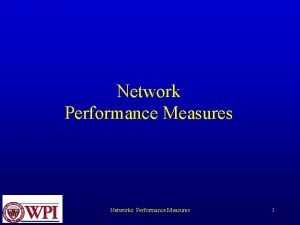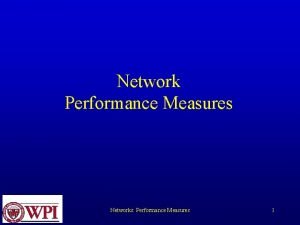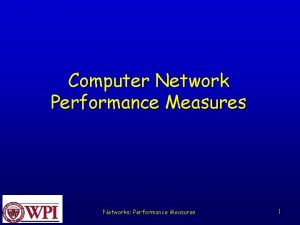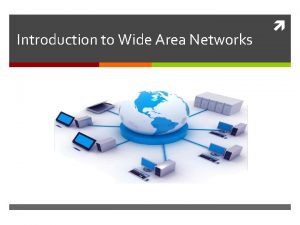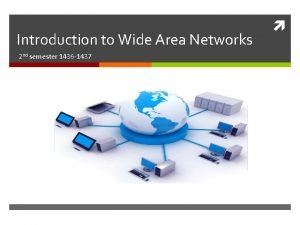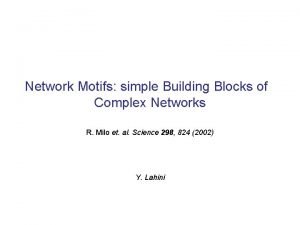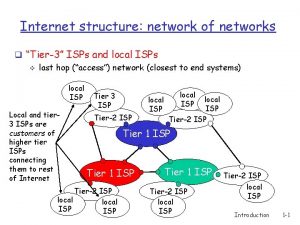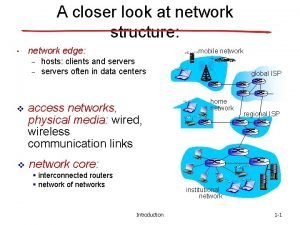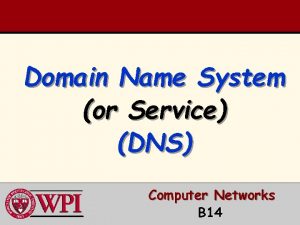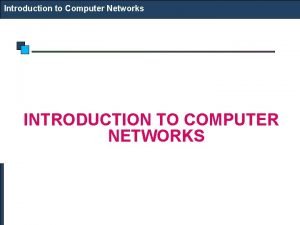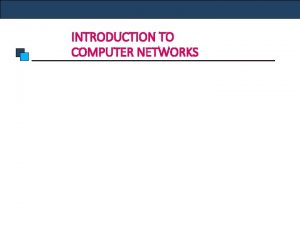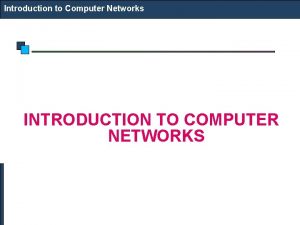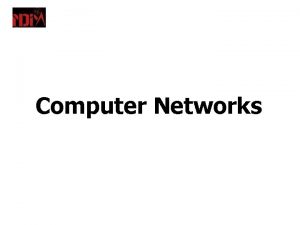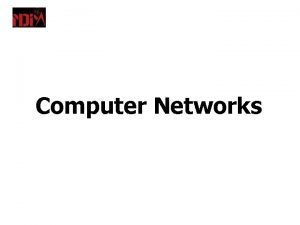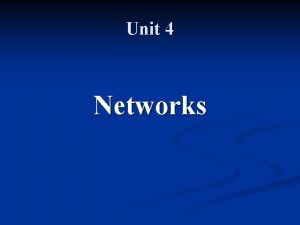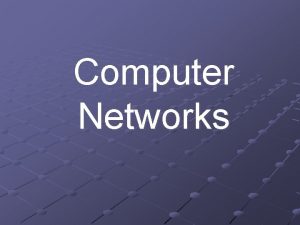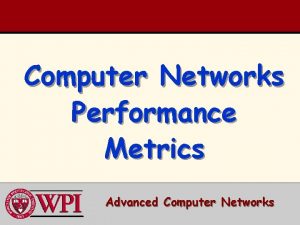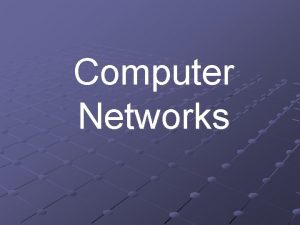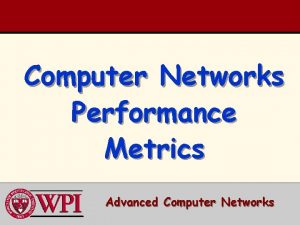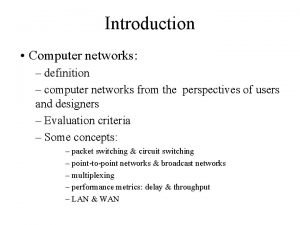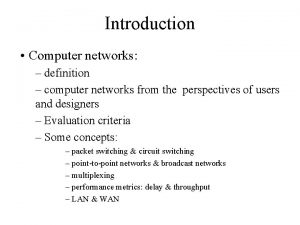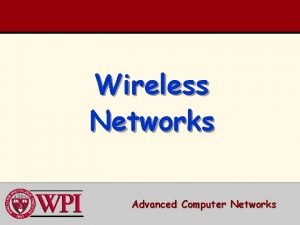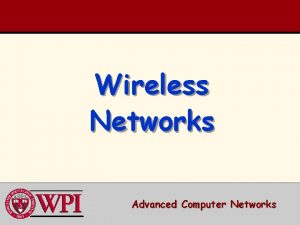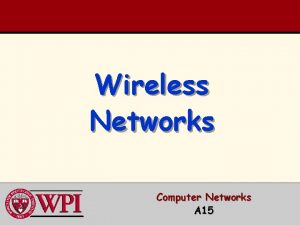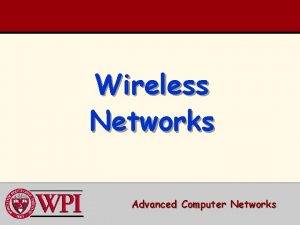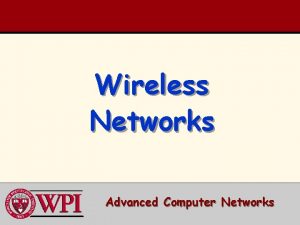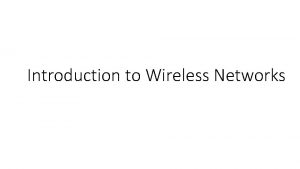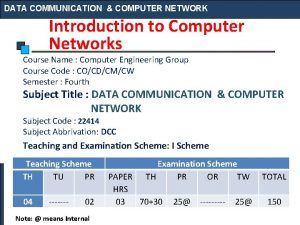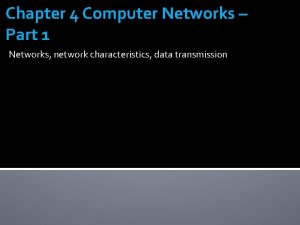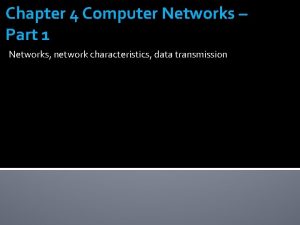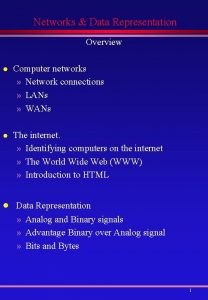Introduction to Networks Computer Network A computer network






































- Slides: 38

Introduction to Networks

Computer Network A computer network is a set of electronically connected computers which can share information and resources among themselves. There are communication protocols that define how this sharing should take place. 2

Data Communication § Data communication is the exchange of data between two devices via a transmission medium § Effectiveness depends on: ° ° ° Delivery Accuracy Timeliness 3

§ Data communications are the exchange of data between two devices via some form of transmission medium such as a wire cable. For data communications to occur, the communicating devices must be part of a communication system made up of a combination of hardware (physical equipment) and software (programs). The effectiveness of a data communications system depends on four fundamental characteristics: delivery, accuracy, timeliness, and jitter. 4

Communication System Components 5

Data Representation § Text – represented as a bit pattern, a sequence of bit (0 s or 1 s); codes often used: ° ASCII; Extended ASCII; Unicode; ISO § Numbers – represented by binary equivalent § Images – bit patterns representing pixels § Audio § Video 6

A Communications Model DTE: Data Terminal Equipment DCE: Data communication Equipment 7

Direction of Data Flow § Simplex – unidirectional; one transmits, other receives 8

§ The half-duplex mode is like a one-lane road with traffic allowed in both directions. § When cars are traveling in one direction, cars going the other way must wait. In a half-duplex transmission, the entire capacity of a channel is taken over by whichever of the two devices is transmitting at the time. § Walkie-talkies and CB (citizens band--Citizens' Band radio (also known as CB radio) is a system of short-distance radio communications between individuals on a selection of channels within the 27 -MHz (11 m) band) radios are both half-duplex systems. 9

Direction of Data Flow (cont) § Half-duplex – each can transmit/receive; communication must alternate 10

Direction of Data Flow (cont) § Full-duplex – both can transmit/receive simultaneously 11

§ The full-duplex mode is like a t. W<D-way street with traffic flowing in both directions at the same time. In full-duplex mode, signals going in one direction share the capacity of the link: with signals going in the other diretion. § This sharing can occur in two ways: Either the link must contain two physically separate t: nmsmissi. IDn paths, one for sending and the other for receiving; or the capacity of the ch: arillilel is divided between signals traveling in both directions. § One common example of full-duplex communication is the telephone network. § The full-duplex mode is used when 12 communication in both directions is required all

Networks § § A network is set of devices (nodes) connected by communication links (media) A node can be a computer, printer, or other device capable of sending and/or receiving data § Link connecting the devices are often called communication channels § Most network use distributed processing 13

Advantages: File sharing The major advantage of a computer network is that it allows file sharing and remote file access. A person sitting at one workstation of a network can easily see the files present on the other workstation, provided he is authorized to do so. It saves the time which is wasted in copying a file from one system to another, by using a storage device. 14

Advantages: File sharing The major advantage of a computer network is that it allows file sharing and remote file access. A person sitting at one workstation of a network can easily see the files present on the other workstation, provided he is authorized to do so. It saves the time which is wasted in copying a file from one system to another, by using a storage device. 15

Advantages: § Resource Sharing: A computer network, provides a the provision of resource sharing. § Increased Storage Capacity: As there is more than one computer on a network which can easily share files, the issue of storage capacity gets resolved to a great extent. One can also design a storage server on the network in order to have a huge storage capacity. 16

§ Increased Cost Efficiency: There are many softwares available in the market which are costly and take time for installation. Computer networks resolve this issue as the software can be stored or installed on a system or a server and can be used by the different workstations. § Increased Performance: The computers network has the ability to increase systemperfomance gradually as the work load gross by adding more processors. 17

Disadvantages: § Security Issues: One of the major drawbacks of computer networks is the security issues involved. Aa computer is on a network, a computer hacker can get unauthorized access by using different tools. In case of big organizations, various network security softwares are used to prevent theft of any confidential and classified data. 18

§ Rapid Spread of Computer Viruses: If any computer system in a network gets affected by computer virus, there is a possible threat of other systems getting affected too. § Expensive Set Up: The initial set up cost of a computer network can be high depending on the number of computers to be connected. Costly devices like routers, switches, hubs, etc § Dependency on the Main File Server: In case the main File Server of a computer network breaks down, the system becomes useless 19

Network Criteria (Standard) § Performance – depends on number of users, type of medium, HW/SW § Reliability – measured by freq of failure, recovery time, catastrophe vulnerability § Security – protection from unauthorized access, viruses/worms 20

Types of Connections § Point-to-point – dedicated link 21

Types of Connections (cont) § Multipoint (Multidrop) – shared a single link 22

Physical Topology § The way in which a network is laid out physically § 4 basic types: mesh, star, bus, ring § May often see hybrid 23

Mesh Topology § Dedicated point-to-point links to every other device § Has n(n-1)/2 physical channel to link n devices § Devices have n-1 I/O § To accommodate that many links , every device on the network must have n-1 i/p ports to be connected the ither n-1 stations. 24

Advantages: § Each connection carry its own data load , thus eliminating the traffic problem that can occure when links must be shared by multiple devices. § Topology is Robust, If one link is unstable it does not inactivate the entire system. § Privacy and Security. § Point to point links make fault identification and fault isolation easy. . 25

Disadvantages: § The main disadvantage of mesh are related to the amount cabling and the number of I/O ports required. § Installation and reconnection are difficult § Hardware required to connect each link can be expensive § For these reaesons a mesh topology is usually implemented as a backbone connecting the main computers of a hybrid network that can include several other topologies. . 26

Eg: § Connection of telephone regional offices in which each regional offices needs to be connected to every other regional office. 27

Star Topology § Dedicated point-to-point links to central controller (hub) § Controller acts as exchange § Less expensive than a mesh topology 28

Advantages: In star topology each device needs only one link and one I/O port to connect to any number of others. § Easy to install and reconfigure and less cabling needed to additional moves and deletions involve only one connection between that device and the hub. § Other advantages include robustness. If one link fails, only that link is affected. All other links remain active. § Fault idenfication and fault isolation and as long as hub is working it can be used to monitor link problems and bypass defective links. 29

Disadvantages: § The whole topology on one single point the hub. . If the hub goes down the whole system is dead. § Usually used in LANs. 30

Bus Topology § Multipoint configuration § One cable acts as a backbone to link all devices in a network. Nodes are connected to the bus cable by drop lines and taps. A drop line is connection running between the device and main cable. a ta[ is a connector to the main c 31

Codes are connected to the bus cable by drop lines and taps. A dropline is a connection between device and main cable. A tap is a connector to the cable. 32

Advantages: - § Advantage of bus topology include ease of installation. § The backbone cable laid along most effiicient path , then connected to the nodes by drop lines of various lengths. § Less cabling than mesh and star. 33

Disavantages: - § Difficult in reconnection and fault asolation. § The Signal reflection and taps can cause degrdation in quality. § To control degradation , number rand spacing of devices connected to a cable of particular length is limited. § Adding a new device may therefore require modification or replacement of backbone. § A fault or break in the bus cable may stops all transmissions. 34

§ Bus topology was one of the first topolgy used in design of early LAN But less popular now. . . 35

Ring Topology § Dedicated point-to-point configuration to neighbors § Signal is passed from device to device until it reaches destination § Each device in a ring incorporates a repeater. 36

Advantages: § The ring is relatively easy to install and reconfigure. § Fault isolation simple. § To add or remove requires only two connections Disadvantages: § In a simple ring break the ring can disable the entire ring. § This weakness cable solved by using dual ring or switch capable for closing of the break. § A ring was common when IBM introduced its local -area network TOKEN Ring. But this topology is less popular now. 37

Disadvantages: § In a simple ring break the ring can disable the entire ring. § This weakness cable solved by using dual ring or switch capable for closing of the break. § A ring was common when IBM introduced its local -area network TOKEN Ring. But this topology is less popular now. 38
 Difference between datagram and virtual circuit approach
Difference between datagram and virtual circuit approach Basestore iptv
Basestore iptv Principles of network applications
Principles of network applications The network layer is concerned with
The network layer is concerned with Network layer design issues in computer networks
Network layer design issues in computer networks Network performance measurement in computer networks
Network performance measurement in computer networks Network performance measurement in computer networks
Network performance measurement in computer networks Network performance measurement in computer networks
Network performance measurement in computer networks Introduction to storage area networks
Introduction to storage area networks Circuit switched wan
Circuit switched wan Newff matlab
Newff matlab Introduction to communication networks
Introduction to communication networks Convolutional neural network presentation
Convolutional neural network presentation Introduction to wide area networks
Introduction to wide area networks Netinsights
Netinsights Introduction to switched networks
Introduction to switched networks Types of network topology
Types of network topology Palo alto networks certified network security consultant
Palo alto networks certified network security consultant Network motifs: simple building blocks of complex networks
Network motifs: simple building blocks of complex networks Tier 3 isps
Tier 3 isps Internet structure network of networks
Internet structure network of networks Crc in computer networks
Crc in computer networks Crc in computer networks
Crc in computer networks Traffic management in computer networks
Traffic management in computer networks Speed of a computer
Speed of a computer What is optimality principle in computer networks
What is optimality principle in computer networks Snmp ports
Snmp ports What is optimality principle in computer networks
What is optimality principle in computer networks Business applications in computer networks
Business applications in computer networks Classify computer networks based on transmission technology
Classify computer networks based on transmission technology Intro dns
Intro dns Intserv vs diffserv
Intserv vs diffserv Icmp in computer networks
Icmp in computer networks Web and http in computer networks
Web and http in computer networks Character stuffing in computer networks
Character stuffing in computer networks Dns in computer networks
Dns in computer networks Computer networks assignment 1
Computer networks assignment 1 Difference between computer network and distributed system
Difference between computer network and distributed system Routing algorithms in computer networks
Routing algorithms in computer networks





